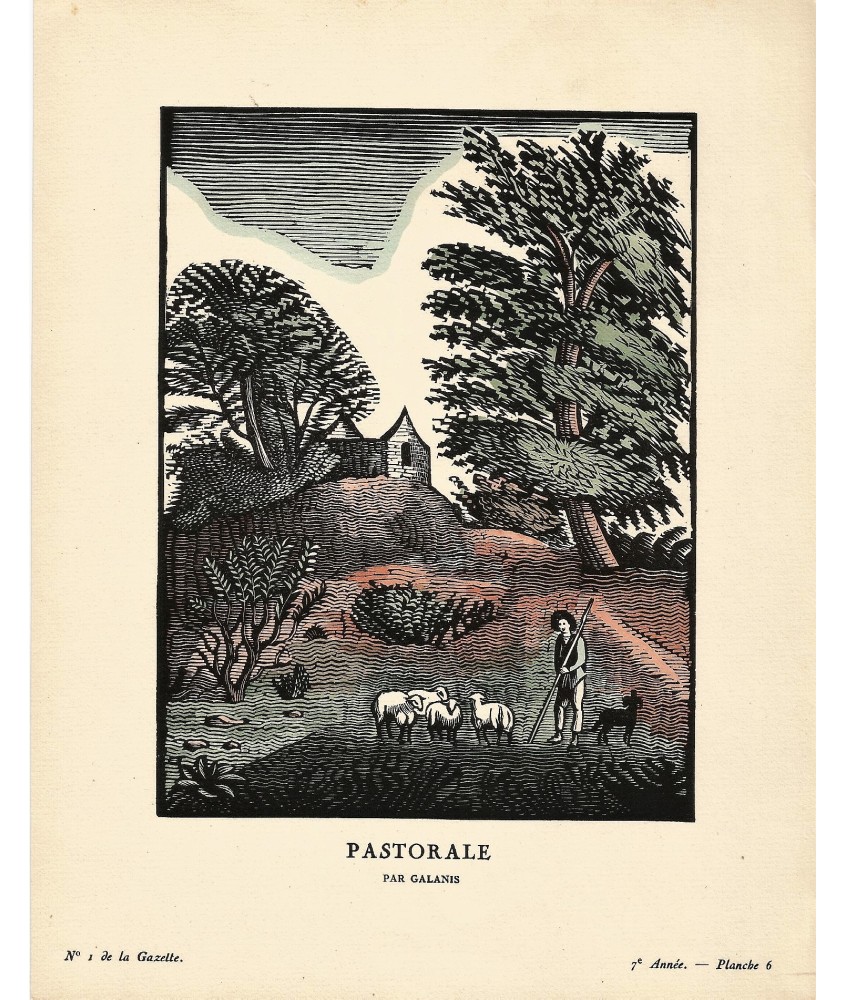- Out-of-Stock


Nº 1 GAZETTE DU BON TON. PLANCHE 6. 1924-1925
The Gazette du Bon Ton, put out by the retailer of the same name, was considered the trendsetting magazine of the era. Founded by Lucien Vogel and targeting Paris's upper class, it ran from 1912-1925.
Principio del formularioThe Gazette du Bon Ton, put out by the retailer of the same name, was considered the trendsetting magazine of the era. Founded by Lucien Vogel and targeting Paris's upper class, it ran from 1912-1925. Only ten colour plates were printed per issue, and artists vied for the prestige of illustrating the latest Parisian fashion and lifestyle trends. As these pochoirs attest, the high style and iconic femininity made the items featured in the pages "must have's" -- right down to the prayer statue on top of the chest of drawers!
This pochoir - created when single layers of color are added by hand to a lithograph using a stencil – shows.
Demetrios Emmanuel Galanis, also known as Demetrius-Emmanuel Galanis1, is a naturalized Greek painter and engraver born in Kymi (island of Evia, Greece) on May 17, 1879 and died in Athens on March 20, 19662.
First satirical designer, then landscape designer, he then devoted himself to engraving.
Demetrios Galanis entered Fernand Cormon's studio at École des Beaux-Arts in Paris in 1900. He collaborated in French comic or satirical newspapers, such as L'Assiette au Beurre3, Le Cri de Paris4, Gil Blas, Le Rire, Le Canard Sauvage5, Le Témoin, and Germans, such as Simplicissimus, Lustige Blätter, where Pascin also collaborates, which he will present to French newspapers when he arrives in Paris in 1907. For these newspapers, he draws up a vast panorama of the places of Parisian pleasures. At the same time, Galanis produces advertising posters6.
In 1904, he exhibited at the Salon of the National Society of Fine Arts, then at the Salon d'automne, at the Salon des humoristes and at the Salon des independants.
In Paris, Galanis frequents intellectual circles and meets Jean Moréas, André Derain, Henri Matisse and Aristide Maillol. His aesthetic is closer to that of Maillol than Matisse. He is the first artist of Greek origin to be recognized as a full member of the European avant-garde. In 1912, he participated with the Cubists in the exhibition of the Golden Section. His painted work is mainly composed of landscapes, especially from the South, and still lifes, of which he exhibited three issues at the Salon des Indépendants in 1914. During the First World War, he joined the Foreign Legion and, in Corfu, he acquired French nationality.
Upon his return, Galanis abandoned press cartoons and devoted himself to engraving. First the woodcut and then the etchings. For wood engraving, he uses a technique of illustrators from the 19th century: the bicycle, a two or six-edged chisel allowing two or six parallel lines to be drawn simultaneously.
In 1920, the year in which he completed his Seated Nude, he participated in an exhibition alongside other proponents of modern art such as Matisse and Georges Braque and in 1921 with Juan Gris, Raoul Dufy, Marc Chagall and Pablo Picasso.
In the early 1920s, well known in France, Galanis prepared performances in Brussels, London and New York. In 1922, a first solo exhibition was dedicated to him at the La Licorne gallery and aroused the enthusiasm of critics and strengthened his reputation. The Seated Nude is among the works on display. In his preface to the exhibition catalog, André Malraux describes his work as "being capable of provoking emotions comparable to those of Giotto" 7.
In 1922, the Parisian press (Le Crapouillot) reported on the exhibition of artists Constant Le Breton, Jean Lébédeff, Paul Hermann, Roger-Maurice Grillon, Jacques Beltrand, Robert Bonfils, Louis Bouquet, Paul-Émile Colin, Georges Gimel, Démétrios Galanis, Carlègle, André Deslignères and their woodcuts at the Le Nouvel Essor gallery, which precedes their joint hanging, at the beginning of 1923, at the Salon of the Society of Original Wood Engraving, at the Pavillon de Marsan.
For the 1937 Universal Exhibition in Paris, Galanis produced four stamps of the “Genie” type which were issued on September 15, 19368.
Professor of Fine Arts in Paris, he was elected member of the Academy of Fine Arts in 1945.